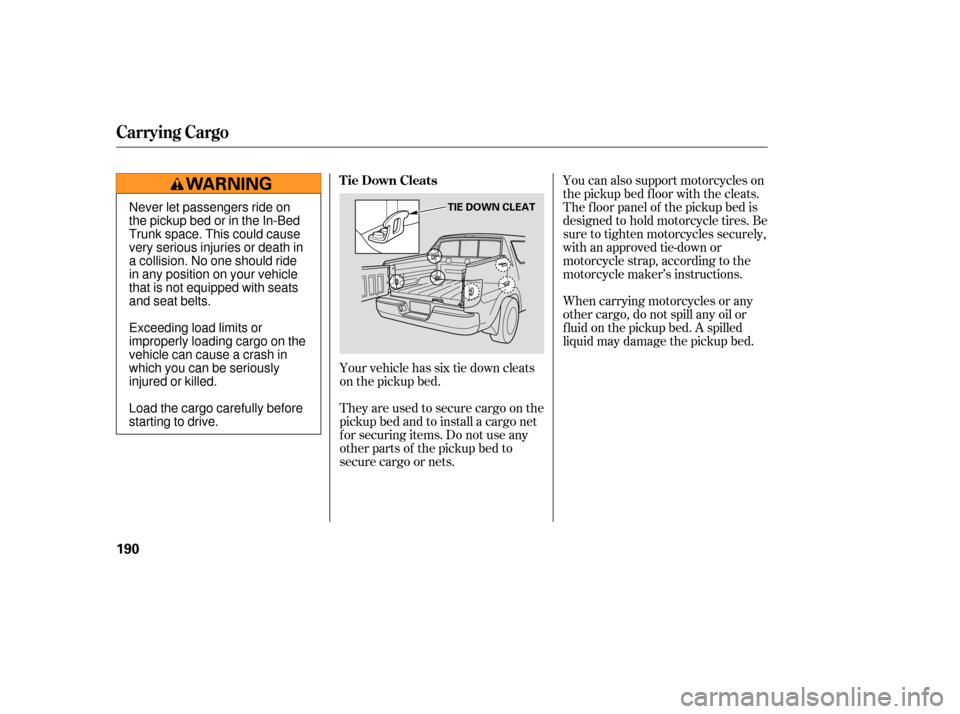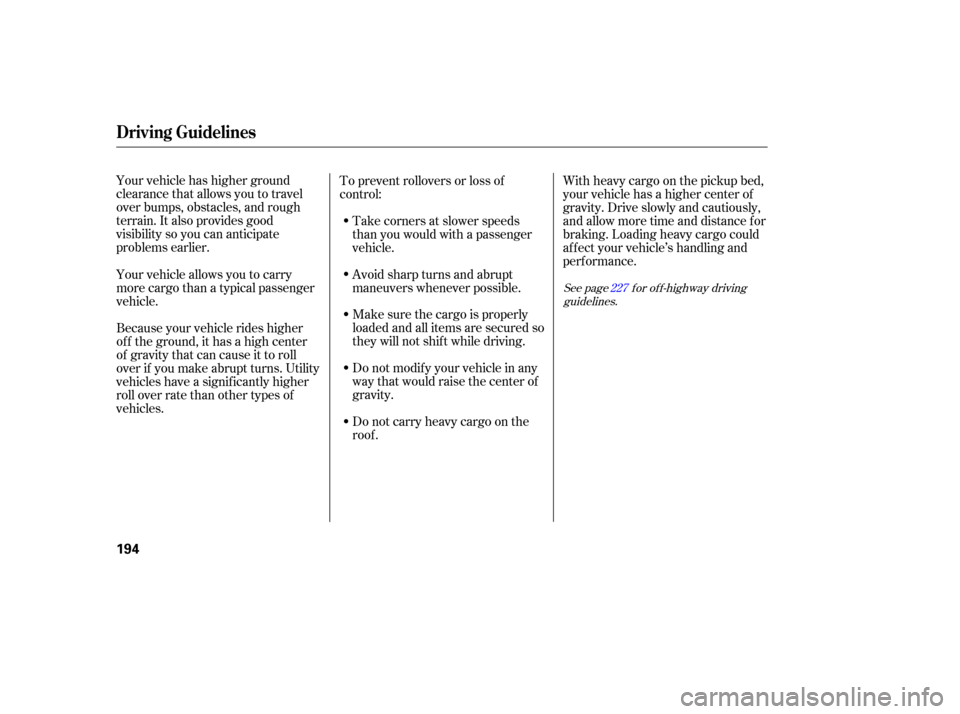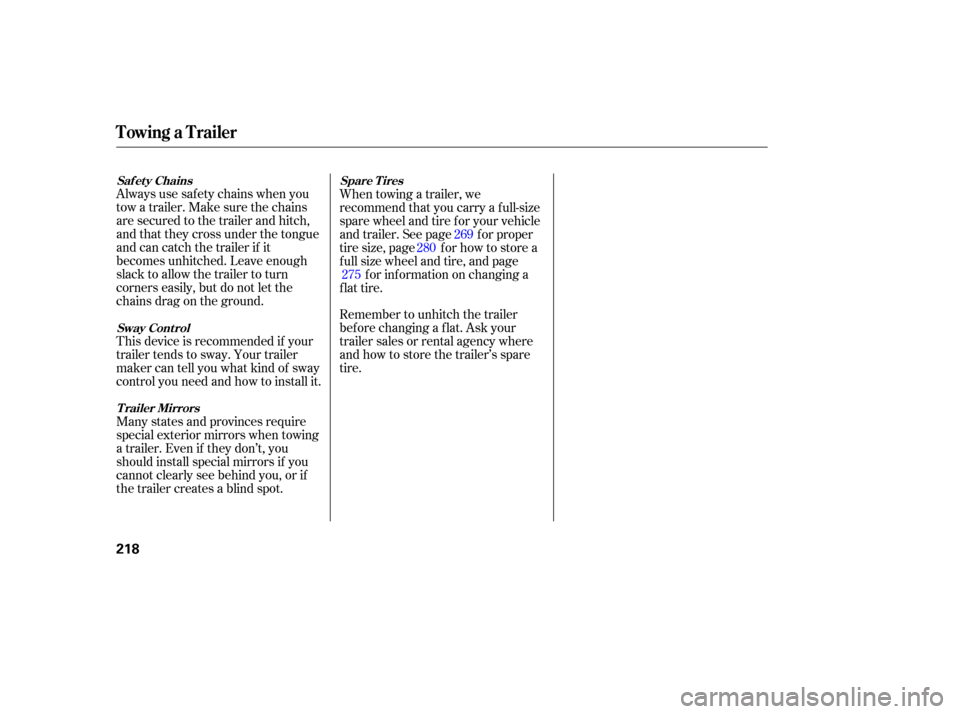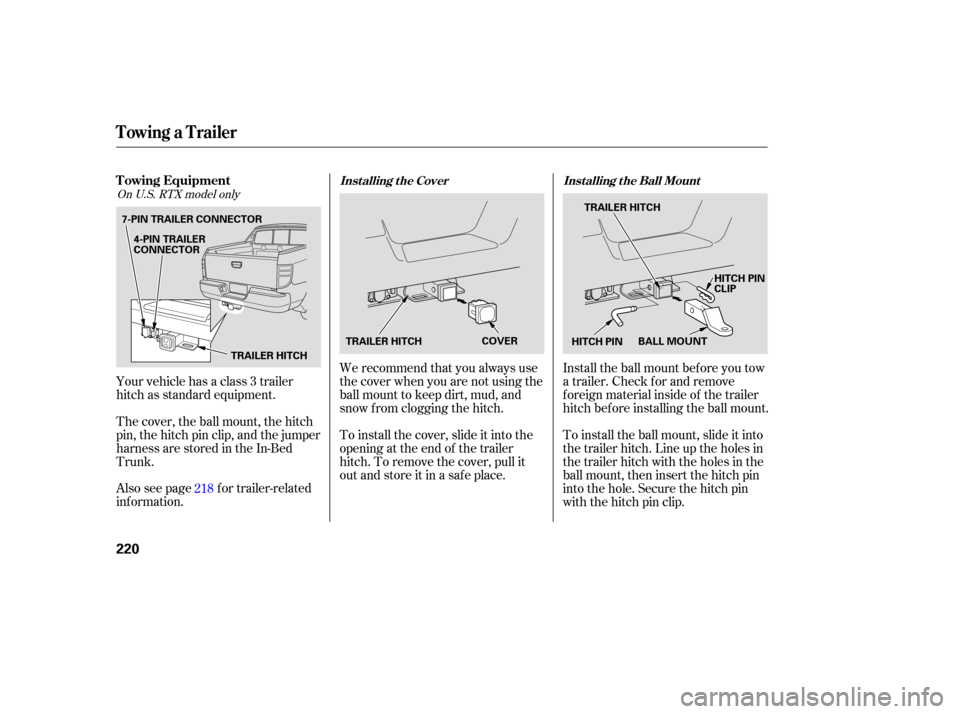Page 194 of 331

Your vehicle has six tie down cleats
on the pickup bed.You can also support motorcycles on
the pickup bed floor with the cleats.
The f loor panel of the pickup bed is
designed to hold motorcycle tires. Be
sure to tighten motorcycles securely,
with an approved tie-down or
motorcycle strap, according to the
motorcycle maker’s instructions.
They are used to secure cargo on the
pickup bed and to install a cargo net
f or securing items. Do not use any
other parts of the pickup bed to
secure cargo or nets. When carrying motorcycles or any
other cargo, do not spill any oil or
f luid on the pickup bed. A spilled
liquid may damage the pickup bed.
Carrying Cargo
Tie Down Cleats
190
TIE DOWN CLEATNever let passengers ride on
the pickup bed or in the In-Bed
Trunk space. This could cause
very serious injuries or death in
a collision. No one should ride
in any position on your vehicle
that is not equipped with seats
and seat belts.
Exceeding load limits or
improperly loading cargo on the
vehicle can cause a crash in
which you can be seriously
injured or killed.
Load the cargo carefully before
starting to drive.
Page 195 of 331
The cargo net can be used to hold
lightweight items in the pickup bed.
Secure all items properly. The net
may not prevent heavy items f rom
beingthrownoutwardinacrashora
sudden stop.The cargo cover can be used to
cover the cargo area on the pickup
bed.
Your vehicle’s pickup bed has a rust
resistant surf ace. To repair small
chips and scratches in the bed, a
repair kit is available f rom your
dealer. More extensive damage
should be repaired by your dealer.
To avoid problems with the bed
surf ace and the In-Bed Trunk lid, do
not use spray-in bed liner products.
Carrying Cargo
Optional Cargo Net
Optional Cargo Cover
Pickup Bed Repair
Bef ore Driving
191
Page 198 of 331

Your vehicle has higher ground
clearance that allows you to travel
over bumps, obstacles, and rough
terrain. It also provides good
visibility so you can anticipate
problems earlier. Wi
th heavy cargo on the pickup bed,
your vehicle has a higher center of
gravity. Drive slowly and cautiously,
and allow more time and distan ce for
braking. Loading heavy cargo could
affect your vehicl e’s handling and
performance.
To
prevent rollovers or loss of
control:
Take corners at slower speeds
than you would with a passenger
vehicle.
Avoid sharp turns and abrupt
maneuvers whenever possible.
Make sure the cargo is properly
load ed and all items are secu red so
they will not shift while driving.
Do not modify your vehicle in any
way that would raise the center of
gravity.
Do not carry heavy cargo on the
roof.
Your
vehicle allows you to carry
more cargo than a typical passenger
vehicle.
Because your vehicle rides higher
off the ground, it has a high center
of gravity that can cause it to roll
over if you make abrupt turns. Utility
vehicles have a signif icantly higher
roll over rate than other types of
vehicles.
See page f or of f -highway driving
guidelines. 227
Driving Guidelines
194
Page 199 of 331

Youshoulddothefollowingchecks
and adjustmen ts before you drive
your vehicle.
Make sure all windows, mirrors,
and outside lights are clean and
unobstructed. Remove frost, snow,
or ice.
Check that the hood is fully closed.
Check that the tailgate is fully
closed when it is not used as an
exte nded pickup bed.
Vi sually check the tires. If a tire
looks low, use a gauge to check its
pressure.
Check that any items you may be
carrying are stored properly or
fastened down securely. Check
the adjustment of the
inside and outside mirrors (see
page ).
Check the steering wheel
ad justment (see page ).
Make sure the doors and In-Bed
Trunk are securely closed and
locked.
Fasten your seat belt. Check that
your passengers have fastened
their seat belts (see page ).
Wh en you start the engine, check
the gauges and indicato rs in the
instrument panel (see page ).
Check the seat adjustment (see
pages and ).
1.
2.
3.
4.
5.
6.
8. 7.
9.
10.
11. 14
110
79
59
98 100
Preparing to Drive
Driving
195
Page 210 of 331

Make sure the moonroof (if
equipped) and the windows are
closed.
Turn of f the lights.
Place any packages, valuables, etc.
in the cargo area in your vehicle or
the In-Bed Trunk, or take them
with you.
Lock the doors.
Check the indicator on the driver’s
door to verify that the security
system is set.
Never park over dry leaves, tall
grass, or other f lammable
materials. The hot three way
catalytic converter could cause
these materials to catch on fire.
Set the parking brake bef ore you put
the transmission in Park. This keeps
the vehicle from moving and putting
pressure on the parking mechanism
in the transmission. Always use the parking brake when
you park your vehicle. Make sure
the parking brake is set f irmly, or
your vehicle may roll if it is parked
on an incline.
On vehicles with security system
As required by the FCC:
This device complies with Part 15 of theFCC rules. Operation is subject to thef ollowing two conditions: (1) This devicemay not cause harmf ul interf erence, and(2) this device must accept anyinterf erence received, includinginterf erence that may cause undesiredoperation.
Changes or modif ications not expresslyapproved by the party responsible f orcompliance could void the user’sauthority to operate the equipment.
This device complies with IndustryCanada Standard RSS-210.Operation is subject to the f ollowing twoconditions: (1) this device may not causeinterf erence, and (2) this device mustaccept any interf erence that may causeundesired operation of the device.
Parking T ips
Parking
Tire Pressure Monitoring System (TPMS), Parking
206
Page 222 of 331

Always use safety chains when you
tow a trailer. Make sure the chains
are secured to the trailer and hitch,
and that they cross under the tongue
and can catch the trailer if it
becomes unhitched. Leave enough
sl ack to allow the trailer to turn
co rners easily, but do not let the
ch ains drag on the ground.
This device is recommended if your
trailer tends to sway. Your trailer
maker can tell you what kind of sway
control you need and how to install it.
Many states and provinces require
special exterior mirrors when towing
a trailer. Even if they don’t, you
should install special mirrors if you
cannot clearly see behind you, or if
the trailer creates a blind spot. When
towing a trailer, we
recommend that you carry a full-size
spare wheel and tire for your vehicle
and trailer. See page for proper
tire size, page for how to store a
full size wheel and tire, and page
f or inf ormation on changing a
flat tire.
Remember to unhitch the trailer
bef ore changing a f lat. Ask your
trailer sales or rental agency where
and how to store the trailer’s spare
tire. 269
280
275
Saf et y Chains
Sway Cont rolTrailer Mirrors Spare Tires
Towing a Trailer
218
Page 224 of 331

Your vehicle has a class 3 trailer
hitch as standard equipment.
The cover, the ball mount, the hitch
pin, the hitch pin clip, and the jumper
harness are stored in the In-Bed
Trunk.
Also see page f or trailer-related
inf ormation. We recommend that you always use
the cover when you are not using the
ball mount to keep dirt, mud, and
snow f rom clogging the hitch.
To install the cover, slide it into the
opening at the end of the trailer
hitch. To remove the cover, pull it
out and store it in a saf e place.
Install the ball mount bef ore you tow
a trailer. Check f or and remove
f oreign material inside of the trailer
hitch bef ore installing the ball mount.
To install the ball mount, slide it into
the trailer hitch. Line up the holes in
the trailer hitch with the holes in the
ball mount, then insert the hitch pin
into the hole. Secure the hitch pin
with the hitch pin clip.
218
On U.S. RTX model only
Towing a Trailer
Towing EquipmentInst alling t he Cover
Inst alling t he Ball Mount
220
TRAILER HITCH
7-PIN TRAILER CONNECTOR
4-PIN TRAILER
CONNECTOR
TRAILER HITCHCOVER
HITCH PIN HITCH PIN
CLIP
BALL MOUNT
TRAILER HITCH
Page 225 of 331
CONT INUED
The 7-pin trailer connector is needed
f or the trailer lights. To connect the
connector, do this:Make sure the connector and the
socketarefreeof dirt,moisture,
or other f oreign material.
Open the socket lid by pulling it up. Insert the connector securely into
the socket.
Hook the retaining tab on the
inner side of the lid against the
retaining tab of the connector to
prevent disconnection during
operation.
Remove the socket cover, and
attach it securely over the socket.
Insert the connector into the
socket securely to prevent
disconnection during operation.
The 4-pin trailer connector is also
needed f or the trailer lights. To
connect the connector, do this:
1. 1.
2. 3.
4.
2.
Towing a Trailer
Connect ing t he T railer Connect ors
Driving
221
7-PIN TRAILER CONNECTOR SOCKETRETAINING
TAB
RETAINING
TAB
LID
4-PIN TRAILER CONNECTORSOCKET COVER
7-PIN TRAILER
CONNECTOR 4-PIN TRAILER
CONNECTOR